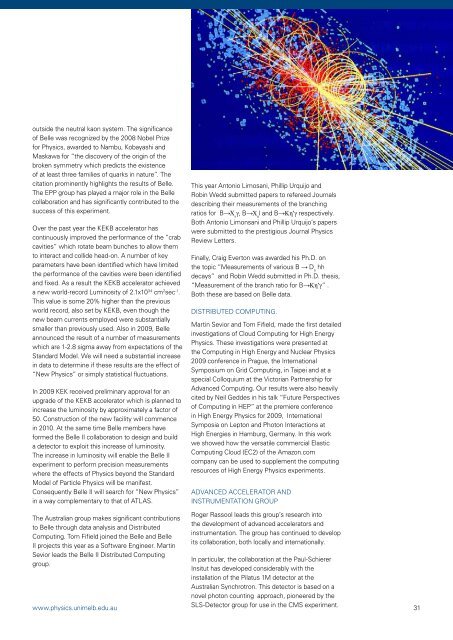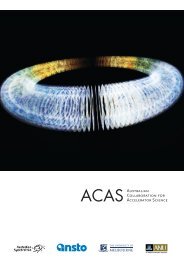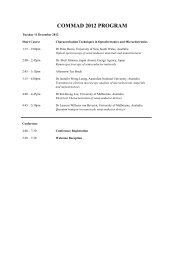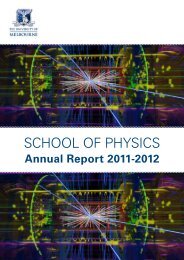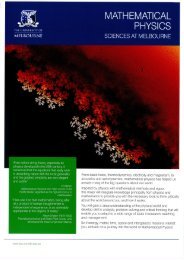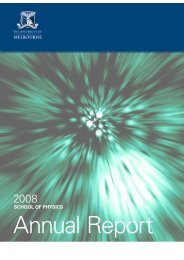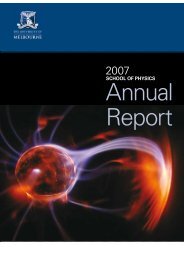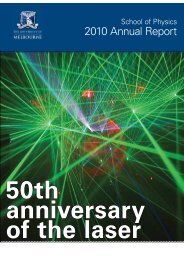Annual Report 2009.pdf - School of Physics - University of Melbourne
Annual Report 2009.pdf - School of Physics - University of Melbourne
Annual Report 2009.pdf - School of Physics - University of Melbourne
- No tags were found...
You also want an ePaper? Increase the reach of your titles
YUMPU automatically turns print PDFs into web optimized ePapers that Google loves.
outside the neutral kaon system. The significance<strong>of</strong> Belle was recognized by the 2008 Nobel Prizefor <strong>Physics</strong>, awarded to Nambu, Kobayashi andMaskawa for “the discovery <strong>of</strong> the origin <strong>of</strong> thebroken symmetry which predicts the existence<strong>of</strong> at least three families <strong>of</strong> quarks in nature”. Thecitation prominently highlights the results <strong>of</strong> Belle.The EPP group has played a major role in the Bellecollaboration and has significantly contributed to thesuccess <strong>of</strong> this experiment.Over the past year the KEKB accelerator hascontinuously improved the performance <strong>of</strong> the “crabcavities” which rotate beam bunches to allow themto interact and collide head-on. A number <strong>of</strong> keyparameters have been identified which have limitedthe performance <strong>of</strong> the cavities were been identifiedand fixed. As a result the KEKB accelerator achieveda new world-record Luminosity <strong>of</strong> 2.1x10 34 cm 2 sec -1 .This value is some 20% higher than the previousworld record, also set by KEKB, even though thenew beam currents employed were substantiallysmaller than previously used. Also in 2009, Belleannounced the result <strong>of</strong> a number <strong>of</strong> measurementswhich are 1-2.8 sigma away from expectations <strong>of</strong> theStandard Model. We will need a substantial increasein data to determine if these results are the effect <strong>of</strong>“New <strong>Physics</strong>” or simply statistical fluctuations.In 2009 KEK received preliminary approval for anupgrade <strong>of</strong> the KEKB accelerator which is planned toincrease the luminosity by approximately a factor <strong>of</strong>50. Construction <strong>of</strong> the new facility will commencein 2010. At the same time Belle members haveformed the Belle II collaboration to design and builda detector to exploit this increase <strong>of</strong> luminosity.The increase in luminosity will enable the Belle IIexperiment to perform precision measurementswhere the effects <strong>of</strong> <strong>Physics</strong> beyond the StandardModel <strong>of</strong> Particle <strong>Physics</strong> will be manifest.Consequently Belle II will search for “New <strong>Physics</strong>”in a way complementary to that <strong>of</strong> ATLAS.This year Antonio Limosani, Phillip Urquijo andRobin Wedd submitted papers to refereed Journalsdescribing their measurements <strong>of</strong> the branchingratios for B→X sγ, B→X ul and B→Kη’γ respectively.Both Antonio Limonsani and Phillip Urquijo’s paperswere submitted to the prestigious Journal <strong>Physics</strong>Review Letters.Finally, Craig Everton was awarded his Ph.D. onthe topic “Measurements <strong>of</strong> various B → D shhdecays” and Robin Wedd submitted in Ph.D. thesis,“Measurement <strong>of</strong> the branch ratio for B→Kη’γ” .Both these are based on Belle data.Distributed Computing.Martin Sevior and Tom Fifield, made the first detailedinvestigations <strong>of</strong> Cloud Computing for High Energy<strong>Physics</strong>. These investigations were presented atthe Computing in High Energy and Nuclear <strong>Physics</strong>2009 conference in Prague, the InternationalSymposium on Grid Computing, in Taipei and at aspecial Colloquium at the Victorian Partnership forAdvanced Computing. Our results were also heavilycited by Neil Geddes in his talk “Future Perspectives<strong>of</strong> Computing in HEP” at the premiere conferencein High Energy <strong>Physics</strong> for 2009, InternationalSymposia on Lepton and Photon Interactions atHigh Energies in Hamburg, Germany. In this workwe showed how the versatile commercial ElasticComputing Cloud (EC2) <strong>of</strong> the Amazon.comcompany can be used to supplement the computingresources <strong>of</strong> High Energy <strong>Physics</strong> experiments.Advanced Accelerator andInstrumentation GroupThe Australian group makes significant contributionsto Belle through data analysis and DistributedComputing. Tom Fifield joined the Belle and BelleII projects this year as a S<strong>of</strong>tware Engineer. MartinSevior leads the Belle II Distributed Computinggroup.Roger Rassool leads this group’s research intothe development <strong>of</strong> advanced accelerators andinstrumentation. The group has continued to developits collaboration, both locally and internationally.In particular, the collaboration at the Paul-SchiererInsitut has developed considerably with theinstallation <strong>of</strong> the Pilatus 1M detector at theAustralian Synchrotron. This detector is based on anovel photon counting approach, pioneered by thewww.physics.unimelb.edu.auSLS-Detector group for use in the CMS experiment.31


